The Impact of Empowerment, Creativity on Job Performance: A Study
VerifiedAdded on 2021/09/16
|21
|5742
|269
Report
AI Summary
This report investigates the relationship between frontline service employee empowerment, creativity, and job performance. The study explores a conceptual model, analyzing how employee empowerment influences job performance through creativity, with service climate acting as a moderator. The research utilizes a case study design, collecting data through online questionnaires from frontline employees in the service industry. The methodology includes scales to measure creativity, performance, service climate, and employee empowerment. The findings, analyzed using SPSS, suggest a significant relationship between employee empowerment, creativity, and job performance. The report highlights managerial implications, emphasizing the importance of fostering a creative and empowering environment for frontline employees to enhance customer satisfaction and organizational outcomes. The study concludes that employee empowerment and creativity are crucial for success in today's competitive market, where frontline employees represent the organization to customers.
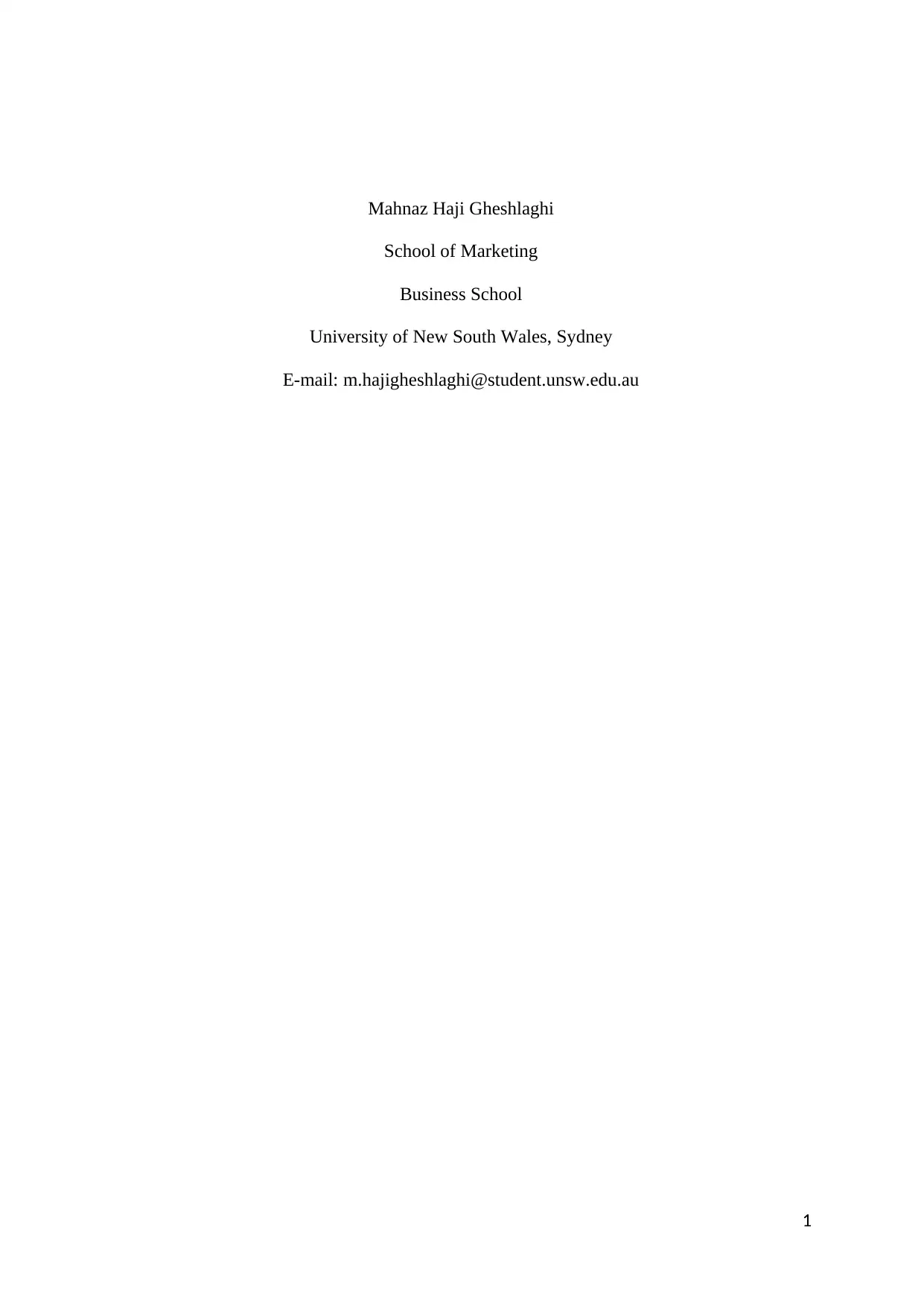
Mahnaz Haji Gheshlaghi
School of Marketing
Business School
University of New South Wales, Sydney
E-mail: m.hajigheshlaghi@student.unsw.edu.au
1
School of Marketing
Business School
University of New South Wales, Sydney
E-mail: m.hajigheshlaghi@student.unsw.edu.au
1
Paraphrase This Document
Need a fresh take? Get an instant paraphrase of this document with our AI Paraphraser
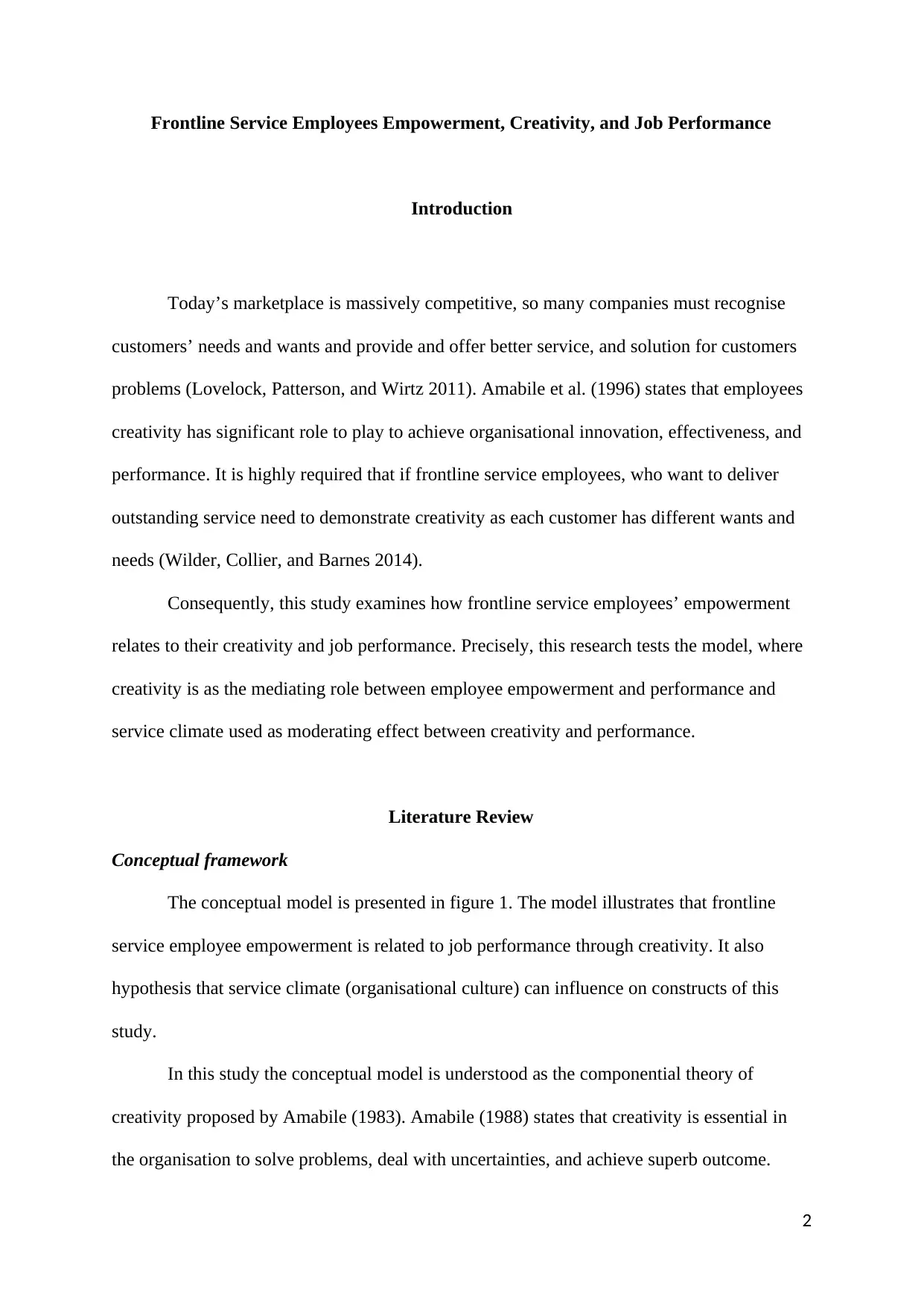
Frontline Service Employees Empowerment, Creativity, and Job Performance
Introduction
Today’s marketplace is massively competitive, so many companies must recognise
customers’ needs and wants and provide and offer better service, and solution for customers
problems (Lovelock, Patterson, and Wirtz 2011). Amabile et al. (1996) states that employees
creativity has significant role to play to achieve organisational innovation, effectiveness, and
performance. It is highly required that if frontline service employees, who want to deliver
outstanding service need to demonstrate creativity as each customer has different wants and
needs (Wilder, Collier, and Barnes 2014).
Consequently, this study examines how frontline service employees’ empowerment
relates to their creativity and job performance. Precisely, this research tests the model, where
creativity is as the mediating role between employee empowerment and performance and
service climate used as moderating effect between creativity and performance.
Literature Review
Conceptual framework
The conceptual model is presented in figure 1. The model illustrates that frontline
service employee empowerment is related to job performance through creativity. It also
hypothesis that service climate (organisational culture) can influence on constructs of this
study.
In this study the conceptual model is understood as the componential theory of
creativity proposed by Amabile (1983). Amabile (1988) states that creativity is essential in
the organisation to solve problems, deal with uncertainties, and achieve superb outcome.
2
Introduction
Today’s marketplace is massively competitive, so many companies must recognise
customers’ needs and wants and provide and offer better service, and solution for customers
problems (Lovelock, Patterson, and Wirtz 2011). Amabile et al. (1996) states that employees
creativity has significant role to play to achieve organisational innovation, effectiveness, and
performance. It is highly required that if frontline service employees, who want to deliver
outstanding service need to demonstrate creativity as each customer has different wants and
needs (Wilder, Collier, and Barnes 2014).
Consequently, this study examines how frontline service employees’ empowerment
relates to their creativity and job performance. Precisely, this research tests the model, where
creativity is as the mediating role between employee empowerment and performance and
service climate used as moderating effect between creativity and performance.
Literature Review
Conceptual framework
The conceptual model is presented in figure 1. The model illustrates that frontline
service employee empowerment is related to job performance through creativity. It also
hypothesis that service climate (organisational culture) can influence on constructs of this
study.
In this study the conceptual model is understood as the componential theory of
creativity proposed by Amabile (1983). Amabile (1988) states that creativity is essential in
the organisation to solve problems, deal with uncertainties, and achieve superb outcome.
2
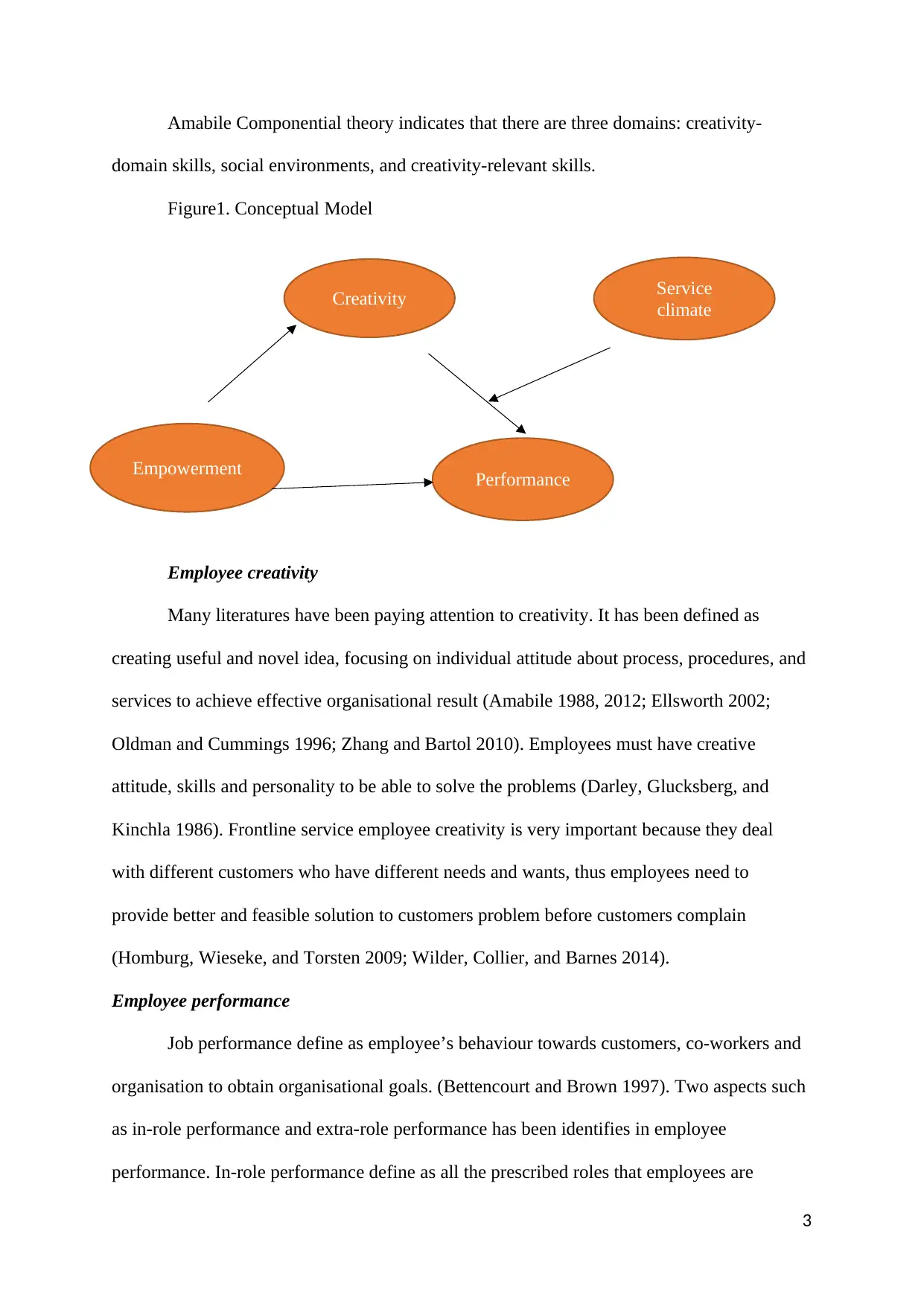
Amabile Componential theory indicates that there are three domains: creativity-
domain skills, social environments, and creativity-relevant skills.
Figure1. Conceptual Model
Employee creativity
Employee creativity
Many literatures have been paying attention to creativity. It has been defined as
creating useful and novel idea, focusing on individual attitude about process, procedures, and
services to achieve effective organisational result (Amabile 1988, 2012; Ellsworth 2002;
Oldman and Cummings 1996; Zhang and Bartol 2010). Employees must have creative
attitude, skills and personality to be able to solve the problems (Darley, Glucksberg, and
Kinchla 1986). Frontline service employee creativity is very important because they deal
with different customers who have different needs and wants, thus employees need to
provide better and feasible solution to customers problem before customers complain
(Homburg, Wieseke, and Torsten 2009; Wilder, Collier, and Barnes 2014).
Employee performance
Job performance define as employee’s behaviour towards customers, co-workers and
organisation to obtain organisational goals. (Bettencourt and Brown 1997). Two aspects such
as in-role performance and extra-role performance has been identifies in employee
performance. In-role performance define as all the prescribed roles that employees are
Empowerment
Creativity
Performance
Service
climate
3
domain skills, social environments, and creativity-relevant skills.
Figure1. Conceptual Model
Employee creativity
Employee creativity
Many literatures have been paying attention to creativity. It has been defined as
creating useful and novel idea, focusing on individual attitude about process, procedures, and
services to achieve effective organisational result (Amabile 1988, 2012; Ellsworth 2002;
Oldman and Cummings 1996; Zhang and Bartol 2010). Employees must have creative
attitude, skills and personality to be able to solve the problems (Darley, Glucksberg, and
Kinchla 1986). Frontline service employee creativity is very important because they deal
with different customers who have different needs and wants, thus employees need to
provide better and feasible solution to customers problem before customers complain
(Homburg, Wieseke, and Torsten 2009; Wilder, Collier, and Barnes 2014).
Employee performance
Job performance define as employee’s behaviour towards customers, co-workers and
organisation to obtain organisational goals. (Bettencourt and Brown 1997). Two aspects such
as in-role performance and extra-role performance has been identifies in employee
performance. In-role performance define as all the prescribed roles that employees are
Empowerment
Creativity
Performance
Service
climate
3
⊘ This is a preview!⊘
Do you want full access?
Subscribe today to unlock all pages.

Trusted by 1+ million students worldwide
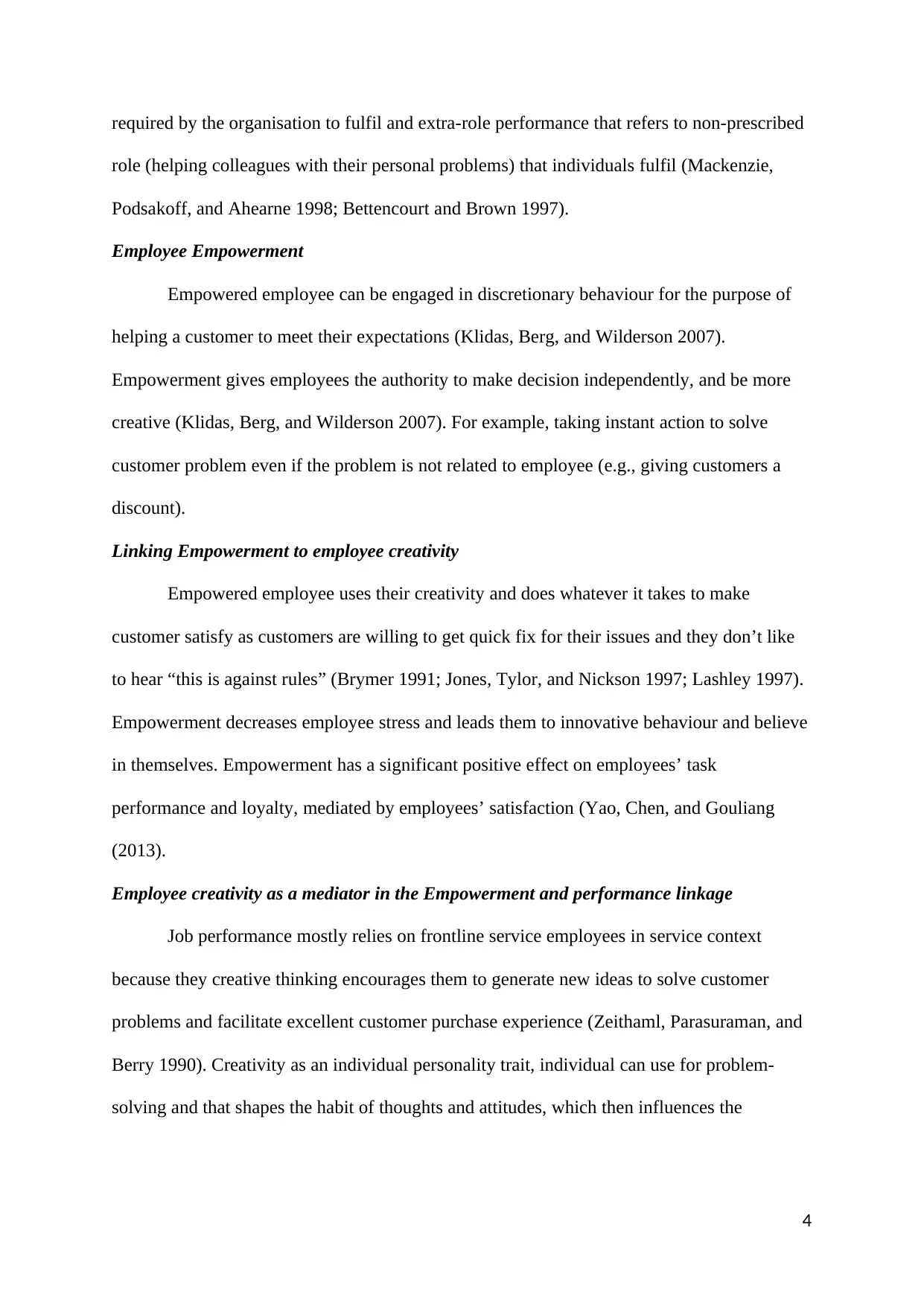
required by the organisation to fulfil and extra-role performance that refers to non-prescribed
role (helping colleagues with their personal problems) that individuals fulfil (Mackenzie,
Podsakoff, and Ahearne 1998; Bettencourt and Brown 1997).
Employee Empowerment
Empowered employee can be engaged in discretionary behaviour for the purpose of
helping a customer to meet their expectations (Klidas, Berg, and Wilderson 2007).
Empowerment gives employees the authority to make decision independently, and be more
creative (Klidas, Berg, and Wilderson 2007). For example, taking instant action to solve
customer problem even if the problem is not related to employee (e.g., giving customers a
discount).
Linking Empowerment to employee creativity
Empowered employee uses their creativity and does whatever it takes to make
customer satisfy as customers are willing to get quick fix for their issues and they don’t like
to hear “this is against rules” (Brymer 1991; Jones, Tylor, and Nickson 1997; Lashley 1997).
Empowerment decreases employee stress and leads them to innovative behaviour and believe
in themselves. Empowerment has a significant positive effect on employees’ task
performance and loyalty, mediated by employees’ satisfaction (Yao, Chen, and Gouliang
(2013).
Employee creativity as a mediator in the Empowerment and performance linkage
Job performance mostly relies on frontline service employees in service context
because they creative thinking encourages them to generate new ideas to solve customer
problems and facilitate excellent customer purchase experience (Zeithaml, Parasuraman, and
Berry 1990). Creativity as an individual personality trait, individual can use for problem-
solving and that shapes the habit of thoughts and attitudes, which then influences the
4
role (helping colleagues with their personal problems) that individuals fulfil (Mackenzie,
Podsakoff, and Ahearne 1998; Bettencourt and Brown 1997).
Employee Empowerment
Empowered employee can be engaged in discretionary behaviour for the purpose of
helping a customer to meet their expectations (Klidas, Berg, and Wilderson 2007).
Empowerment gives employees the authority to make decision independently, and be more
creative (Klidas, Berg, and Wilderson 2007). For example, taking instant action to solve
customer problem even if the problem is not related to employee (e.g., giving customers a
discount).
Linking Empowerment to employee creativity
Empowered employee uses their creativity and does whatever it takes to make
customer satisfy as customers are willing to get quick fix for their issues and they don’t like
to hear “this is against rules” (Brymer 1991; Jones, Tylor, and Nickson 1997; Lashley 1997).
Empowerment decreases employee stress and leads them to innovative behaviour and believe
in themselves. Empowerment has a significant positive effect on employees’ task
performance and loyalty, mediated by employees’ satisfaction (Yao, Chen, and Gouliang
(2013).
Employee creativity as a mediator in the Empowerment and performance linkage
Job performance mostly relies on frontline service employees in service context
because they creative thinking encourages them to generate new ideas to solve customer
problems and facilitate excellent customer purchase experience (Zeithaml, Parasuraman, and
Berry 1990). Creativity as an individual personality trait, individual can use for problem-
solving and that shapes the habit of thoughts and attitudes, which then influences the
4
Paraphrase This Document
Need a fresh take? Get an instant paraphrase of this document with our AI Paraphraser
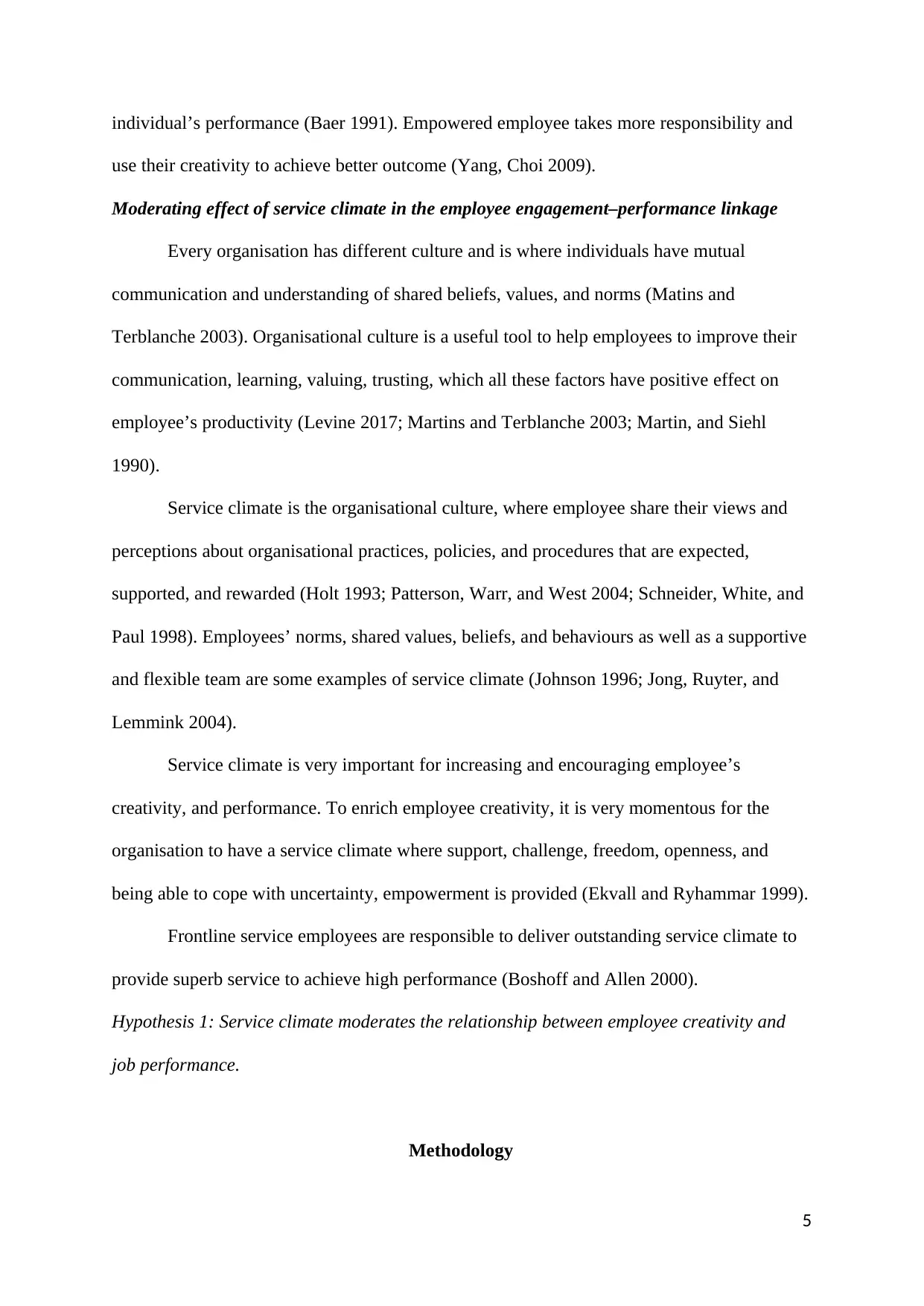
individual’s performance (Baer 1991). Empowered employee takes more responsibility and
use their creativity to achieve better outcome (Yang, Choi 2009).
Moderating effect of service climate in the employee engagement–performance linkage
Every organisation has different culture and is where individuals have mutual
communication and understanding of shared beliefs, values, and norms (Matins and
Terblanche 2003). Organisational culture is a useful tool to help employees to improve their
communication, learning, valuing, trusting, which all these factors have positive effect on
employee’s productivity (Levine 2017; Martins and Terblanche 2003; Martin, and Siehl
1990).
Service climate is the organisational culture, where employee share their views and
perceptions about organisational practices, policies, and procedures that are expected,
supported, and rewarded (Holt 1993; Patterson, Warr, and West 2004; Schneider, White, and
Paul 1998). Employees’ norms, shared values, beliefs, and behaviours as well as a supportive
and flexible team are some examples of service climate (Johnson 1996; Jong, Ruyter, and
Lemmink 2004).
Service climate is very important for increasing and encouraging employee’s
creativity, and performance. To enrich employee creativity, it is very momentous for the
organisation to have a service climate where support, challenge, freedom, openness, and
being able to cope with uncertainty, empowerment is provided (Ekvall and Ryhammar 1999).
Frontline service employees are responsible to deliver outstanding service climate to
provide superb service to achieve high performance (Boshoff and Allen 2000).
Hypothesis 1: Service climate moderates the relationship between employee creativity and
job performance.
Methodology
5
use their creativity to achieve better outcome (Yang, Choi 2009).
Moderating effect of service climate in the employee engagement–performance linkage
Every organisation has different culture and is where individuals have mutual
communication and understanding of shared beliefs, values, and norms (Matins and
Terblanche 2003). Organisational culture is a useful tool to help employees to improve their
communication, learning, valuing, trusting, which all these factors have positive effect on
employee’s productivity (Levine 2017; Martins and Terblanche 2003; Martin, and Siehl
1990).
Service climate is the organisational culture, where employee share their views and
perceptions about organisational practices, policies, and procedures that are expected,
supported, and rewarded (Holt 1993; Patterson, Warr, and West 2004; Schneider, White, and
Paul 1998). Employees’ norms, shared values, beliefs, and behaviours as well as a supportive
and flexible team are some examples of service climate (Johnson 1996; Jong, Ruyter, and
Lemmink 2004).
Service climate is very important for increasing and encouraging employee’s
creativity, and performance. To enrich employee creativity, it is very momentous for the
organisation to have a service climate where support, challenge, freedom, openness, and
being able to cope with uncertainty, empowerment is provided (Ekvall and Ryhammar 1999).
Frontline service employees are responsible to deliver outstanding service climate to
provide superb service to achieve high performance (Boshoff and Allen 2000).
Hypothesis 1: Service climate moderates the relationship between employee creativity and
job performance.
Methodology
5
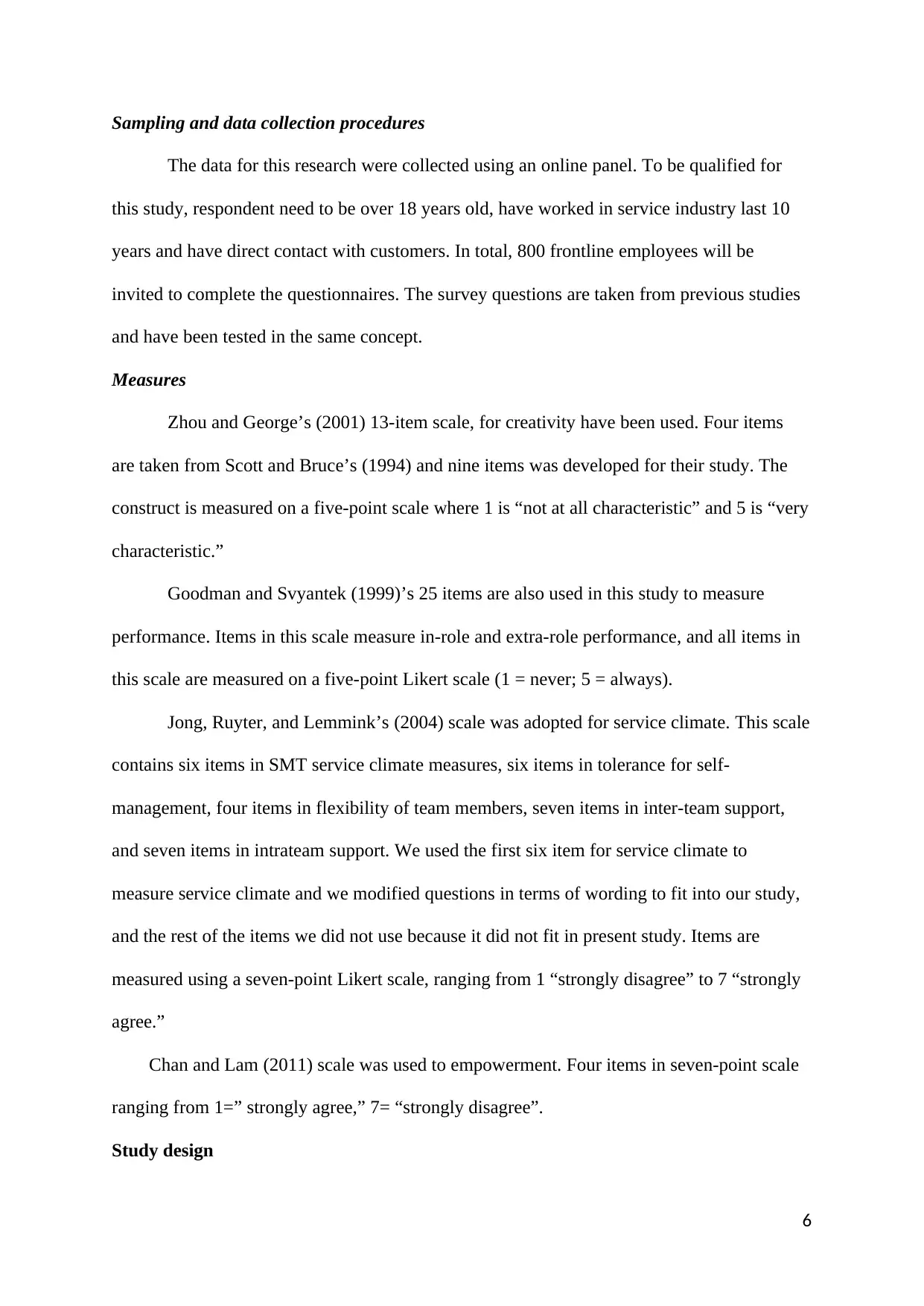
Sampling and data collection procedures
The data for this research were collected using an online panel. To be qualified for
this study, respondent need to be over 18 years old, have worked in service industry last 10
years and have direct contact with customers. In total, 800 frontline employees will be
invited to complete the questionnaires. The survey questions are taken from previous studies
and have been tested in the same concept.
Measures
Zhou and George’s (2001) 13-item scale, for creativity have been used. Four items
are taken from Scott and Bruce’s (1994) and nine items was developed for their study. The
construct is measured on a five-point scale where 1 is “not at all characteristic” and 5 is “very
characteristic.”
Goodman and Svyantek (1999)’s 25 items are also used in this study to measure
performance. Items in this scale measure in-role and extra-role performance, and all items in
this scale are measured on a five-point Likert scale (1 = never; 5 = always).
Jong, Ruyter, and Lemmink’s (2004) scale was adopted for service climate. This scale
contains six items in SMT service climate measures, six items in tolerance for self-
management, four items in flexibility of team members, seven items in inter-team support,
and seven items in intrateam support. We used the first six item for service climate to
measure service climate and we modified questions in terms of wording to fit into our study,
and the rest of the items we did not use because it did not fit in present study. Items are
measured using a seven-point Likert scale, ranging from 1 “strongly disagree” to 7 “strongly
agree.”
Chan and Lam (2011) scale was used to empowerment. Four items in seven-point scale
ranging from 1=” strongly agree,” 7= “strongly disagree”.
Study design
6
The data for this research were collected using an online panel. To be qualified for
this study, respondent need to be over 18 years old, have worked in service industry last 10
years and have direct contact with customers. In total, 800 frontline employees will be
invited to complete the questionnaires. The survey questions are taken from previous studies
and have been tested in the same concept.
Measures
Zhou and George’s (2001) 13-item scale, for creativity have been used. Four items
are taken from Scott and Bruce’s (1994) and nine items was developed for their study. The
construct is measured on a five-point scale where 1 is “not at all characteristic” and 5 is “very
characteristic.”
Goodman and Svyantek (1999)’s 25 items are also used in this study to measure
performance. Items in this scale measure in-role and extra-role performance, and all items in
this scale are measured on a five-point Likert scale (1 = never; 5 = always).
Jong, Ruyter, and Lemmink’s (2004) scale was adopted for service climate. This scale
contains six items in SMT service climate measures, six items in tolerance for self-
management, four items in flexibility of team members, seven items in inter-team support,
and seven items in intrateam support. We used the first six item for service climate to
measure service climate and we modified questions in terms of wording to fit into our study,
and the rest of the items we did not use because it did not fit in present study. Items are
measured using a seven-point Likert scale, ranging from 1 “strongly disagree” to 7 “strongly
agree.”
Chan and Lam (2011) scale was used to empowerment. Four items in seven-point scale
ranging from 1=” strongly agree,” 7= “strongly disagree”.
Study design
6
⊘ This is a preview!⊘
Do you want full access?
Subscribe today to unlock all pages.

Trusted by 1+ million students worldwide
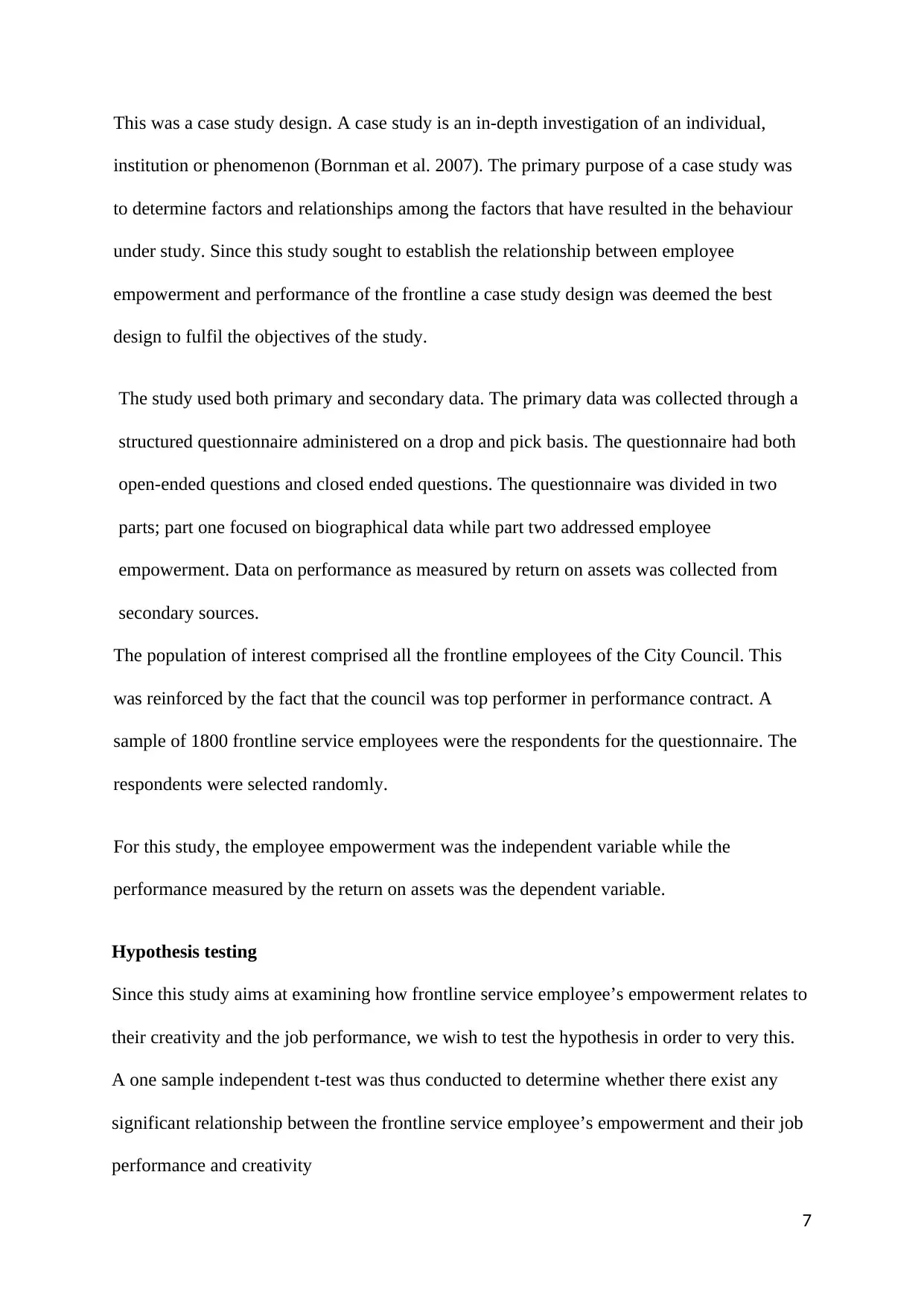
This was a case study design. A case study is an in-depth investigation of an individual,
institution or phenomenon (Bornman et al. 2007). The primary purpose of a case study was
to determine factors and relationships among the factors that have resulted in the behaviour
under study. Since this study sought to establish the relationship between employee
empowerment and performance of the frontline a case study design was deemed the best
design to fulfil the objectives of the study.
The study used both primary and secondary data. The primary data was collected through a
structured questionnaire administered on a drop and pick basis. The questionnaire had both
open-ended questions and closed ended questions. The questionnaire was divided in two
parts; part one focused on biographical data while part two addressed employee
empowerment. Data on performance as measured by return on assets was collected from
secondary sources.
The population of interest comprised all the frontline employees of the City Council. This
was reinforced by the fact that the council was top performer in performance contract. A
sample of 1800 frontline service employees were the respondents for the questionnaire. The
respondents were selected randomly.
For this study, the employee empowerment was the independent variable while the
performance measured by the return on assets was the dependent variable.
Hypothesis testing
Since this study aims at examining how frontline service employee’s empowerment relates to
their creativity and the job performance, we wish to test the hypothesis in order to very this.
A one sample independent t-test was thus conducted to determine whether there exist any
significant relationship between the frontline service employee’s empowerment and their job
performance and creativity
7
institution or phenomenon (Bornman et al. 2007). The primary purpose of a case study was
to determine factors and relationships among the factors that have resulted in the behaviour
under study. Since this study sought to establish the relationship between employee
empowerment and performance of the frontline a case study design was deemed the best
design to fulfil the objectives of the study.
The study used both primary and secondary data. The primary data was collected through a
structured questionnaire administered on a drop and pick basis. The questionnaire had both
open-ended questions and closed ended questions. The questionnaire was divided in two
parts; part one focused on biographical data while part two addressed employee
empowerment. Data on performance as measured by return on assets was collected from
secondary sources.
The population of interest comprised all the frontline employees of the City Council. This
was reinforced by the fact that the council was top performer in performance contract. A
sample of 1800 frontline service employees were the respondents for the questionnaire. The
respondents were selected randomly.
For this study, the employee empowerment was the independent variable while the
performance measured by the return on assets was the dependent variable.
Hypothesis testing
Since this study aims at examining how frontline service employee’s empowerment relates to
their creativity and the job performance, we wish to test the hypothesis in order to very this.
A one sample independent t-test was thus conducted to determine whether there exist any
significant relationship between the frontline service employee’s empowerment and their job
performance and creativity
7
Paraphrase This Document
Need a fresh take? Get an instant paraphrase of this document with our AI Paraphraser
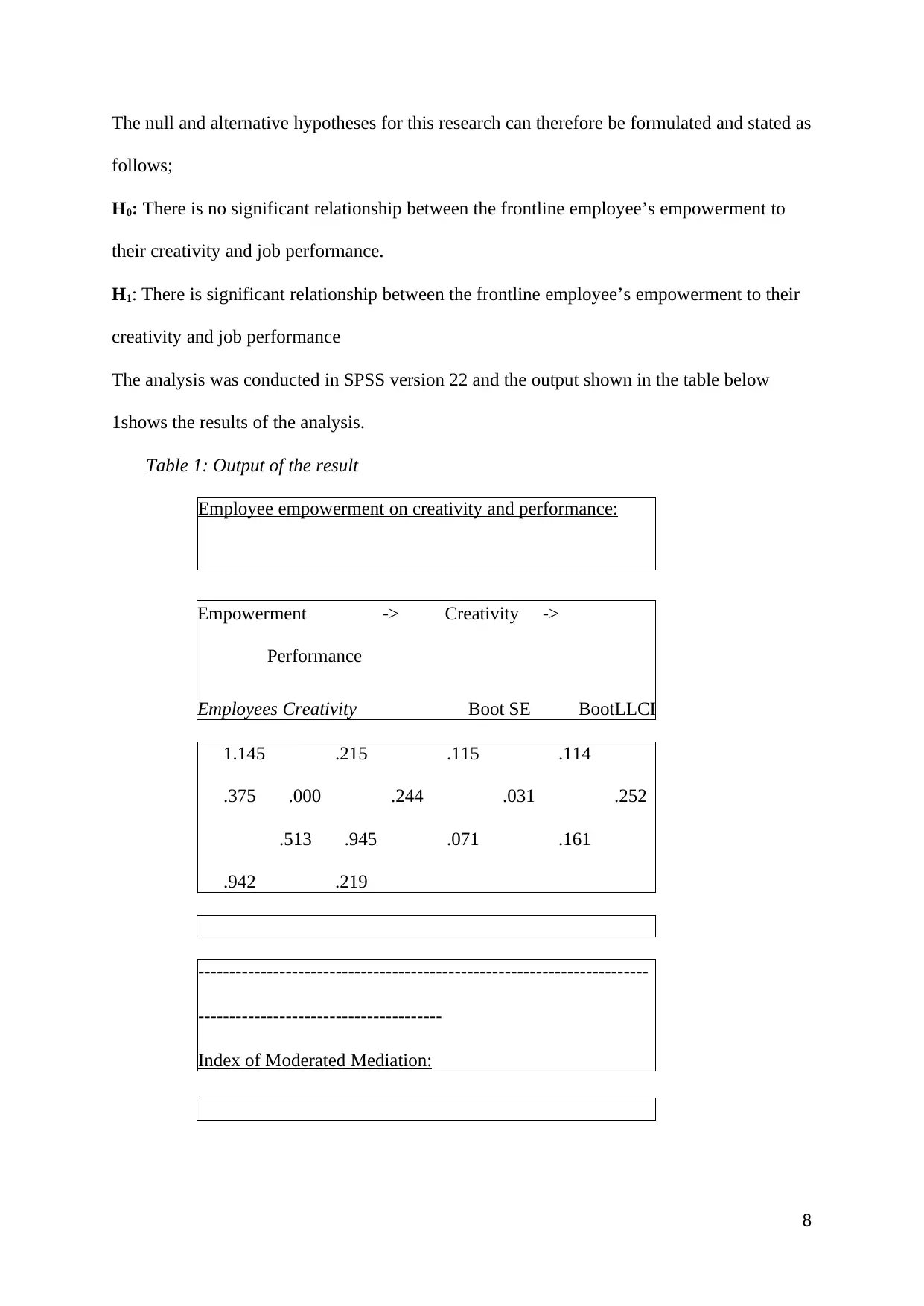
The null and alternative hypotheses for this research can therefore be formulated and stated as
follows;
H0: There is no significant relationship between the frontline employee’s empowerment to
their creativity and job performance.
H1: There is significant relationship between the frontline employee’s empowerment to their
creativity and job performance
The analysis was conducted in SPSS version 22 and the output shown in the table below
1shows the results of the analysis.
Table 1: Output of the result
Employee empowerment on creativity and performance:
Empowerment ‐> Creativity ‐>
Performance
Employees Creativity Boot SE BootLLCI
1.145 .215 .115 .114
.375 .000 .244 .031 .252
.513 .945 .071 .161
.942 .219
‐‐‐‐‐‐‐‐‐‐‐‐‐‐‐‐‐‐‐‐‐‐‐‐‐‐‐‐‐‐‐‐‐‐‐‐‐‐‐‐‐‐‐‐‐‐‐‐‐‐‐‐‐‐‐‐‐‐‐‐‐‐‐‐‐‐‐‐‐‐‐‐
‐‐‐‐‐‐‐‐‐‐‐‐‐‐‐‐‐‐‐‐‐‐‐‐‐‐‐‐‐‐‐‐‐‐‐‐‐‐‐
Index of Moderated Mediation:
8
follows;
H0: There is no significant relationship between the frontline employee’s empowerment to
their creativity and job performance.
H1: There is significant relationship between the frontline employee’s empowerment to their
creativity and job performance
The analysis was conducted in SPSS version 22 and the output shown in the table below
1shows the results of the analysis.
Table 1: Output of the result
Employee empowerment on creativity and performance:
Empowerment ‐> Creativity ‐>
Performance
Employees Creativity Boot SE BootLLCI
1.145 .215 .115 .114
.375 .000 .244 .031 .252
.513 .945 .071 .161
.942 .219
‐‐‐‐‐‐‐‐‐‐‐‐‐‐‐‐‐‐‐‐‐‐‐‐‐‐‐‐‐‐‐‐‐‐‐‐‐‐‐‐‐‐‐‐‐‐‐‐‐‐‐‐‐‐‐‐‐‐‐‐‐‐‐‐‐‐‐‐‐‐‐‐
‐‐‐‐‐‐‐‐‐‐‐‐‐‐‐‐‐‐‐‐‐‐‐‐‐‐‐‐‐‐‐‐‐‐‐‐‐‐‐
Index of Moderated Mediation:
8
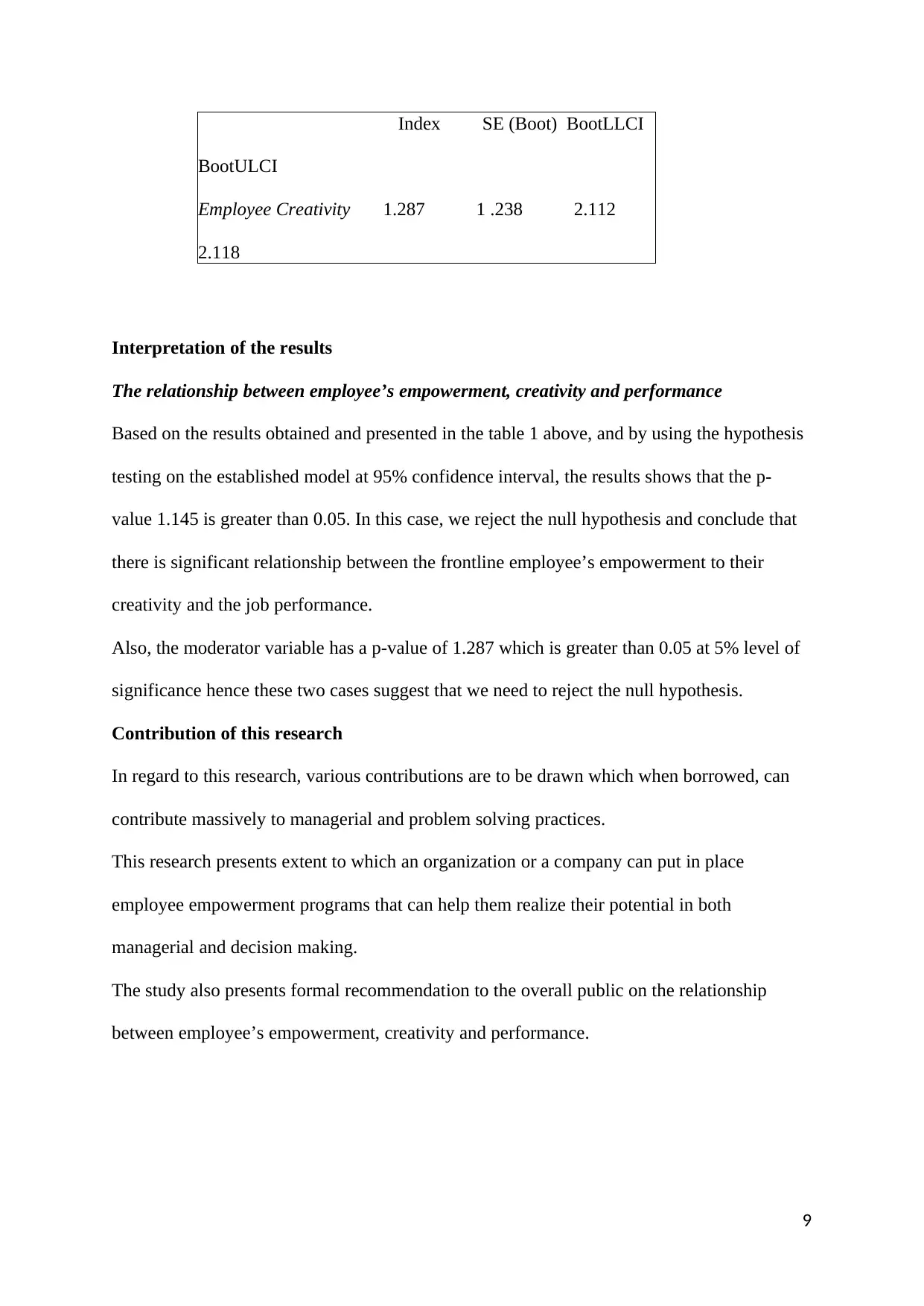
Index SE (Boot) BootLLCI
BootULCI
Employee Creativity 1.287 1 .238 2.112
2.118
Interpretation of the results
The relationship between employee’s empowerment, creativity and performance
Based on the results obtained and presented in the table 1 above, and by using the hypothesis
testing on the established model at 95% confidence interval, the results shows that the p-
value 1.145 is greater than 0.05. In this case, we reject the null hypothesis and conclude that
there is significant relationship between the frontline employee’s empowerment to their
creativity and the job performance.
Also, the moderator variable has a p-value of 1.287 which is greater than 0.05 at 5% level of
significance hence these two cases suggest that we need to reject the null hypothesis.
Contribution of this research
In regard to this research, various contributions are to be drawn which when borrowed, can
contribute massively to managerial and problem solving practices.
This research presents extent to which an organization or a company can put in place
employee empowerment programs that can help them realize their potential in both
managerial and decision making.
The study also presents formal recommendation to the overall public on the relationship
between employee’s empowerment, creativity and performance.
9
BootULCI
Employee Creativity 1.287 1 .238 2.112
2.118
Interpretation of the results
The relationship between employee’s empowerment, creativity and performance
Based on the results obtained and presented in the table 1 above, and by using the hypothesis
testing on the established model at 95% confidence interval, the results shows that the p-
value 1.145 is greater than 0.05. In this case, we reject the null hypothesis and conclude that
there is significant relationship between the frontline employee’s empowerment to their
creativity and the job performance.
Also, the moderator variable has a p-value of 1.287 which is greater than 0.05 at 5% level of
significance hence these two cases suggest that we need to reject the null hypothesis.
Contribution of this research
In regard to this research, various contributions are to be drawn which when borrowed, can
contribute massively to managerial and problem solving practices.
This research presents extent to which an organization or a company can put in place
employee empowerment programs that can help them realize their potential in both
managerial and decision making.
The study also presents formal recommendation to the overall public on the relationship
between employee’s empowerment, creativity and performance.
9
⊘ This is a preview!⊘
Do you want full access?
Subscribe today to unlock all pages.

Trusted by 1+ million students worldwide
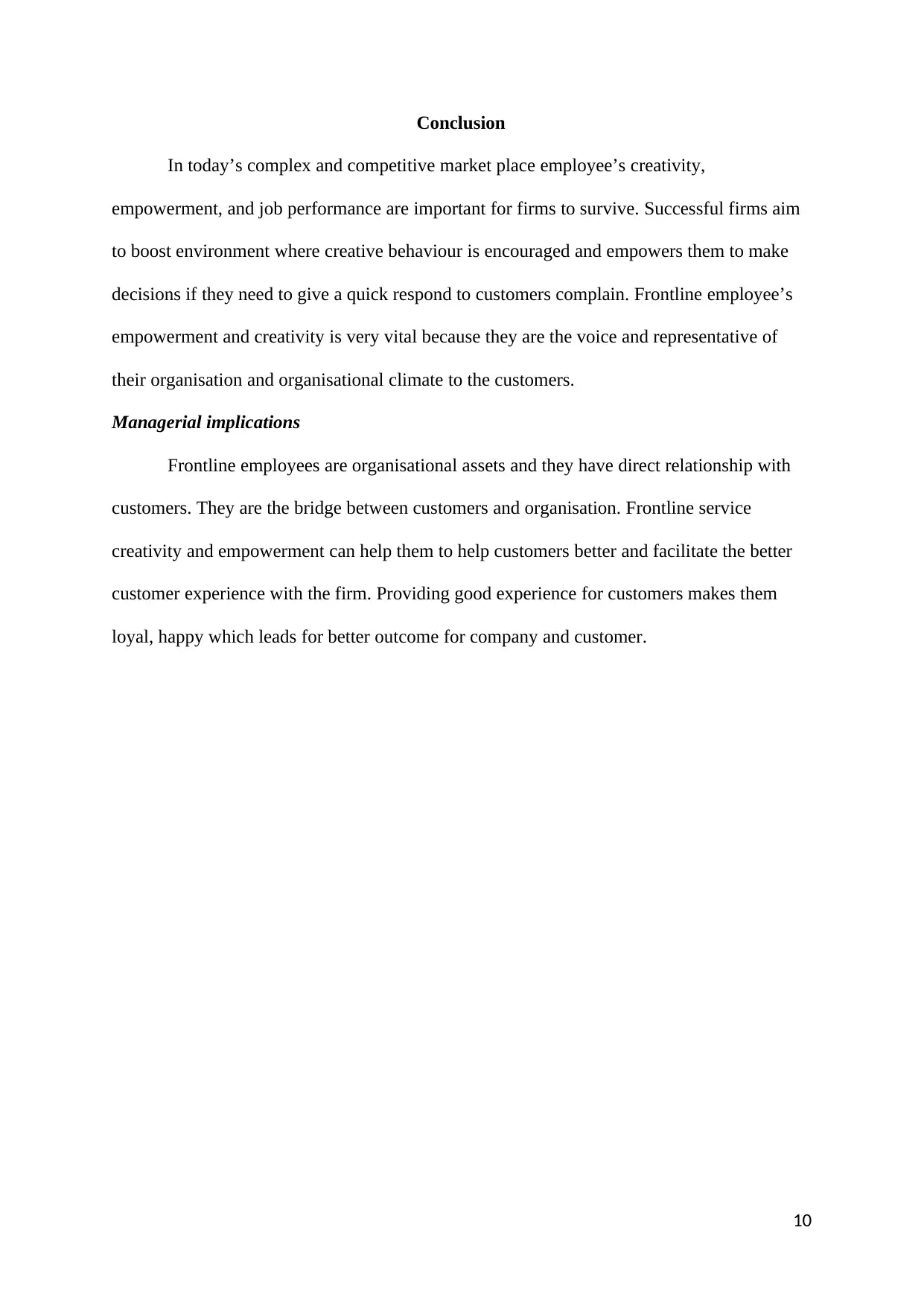
Conclusion
In today’s complex and competitive market place employee’s creativity,
empowerment, and job performance are important for firms to survive. Successful firms aim
to boost environment where creative behaviour is encouraged and empowers them to make
decisions if they need to give a quick respond to customers complain. Frontline employee’s
empowerment and creativity is very vital because they are the voice and representative of
their organisation and organisational climate to the customers.
Managerial implications
Frontline employees are organisational assets and they have direct relationship with
customers. They are the bridge between customers and organisation. Frontline service
creativity and empowerment can help them to help customers better and facilitate the better
customer experience with the firm. Providing good experience for customers makes them
loyal, happy which leads for better outcome for company and customer.
10
In today’s complex and competitive market place employee’s creativity,
empowerment, and job performance are important for firms to survive. Successful firms aim
to boost environment where creative behaviour is encouraged and empowers them to make
decisions if they need to give a quick respond to customers complain. Frontline employee’s
empowerment and creativity is very vital because they are the voice and representative of
their organisation and organisational climate to the customers.
Managerial implications
Frontline employees are organisational assets and they have direct relationship with
customers. They are the bridge between customers and organisation. Frontline service
creativity and empowerment can help them to help customers better and facilitate the better
customer experience with the firm. Providing good experience for customers makes them
loyal, happy which leads for better outcome for company and customer.
10
Paraphrase This Document
Need a fresh take? Get an instant paraphrase of this document with our AI Paraphraser
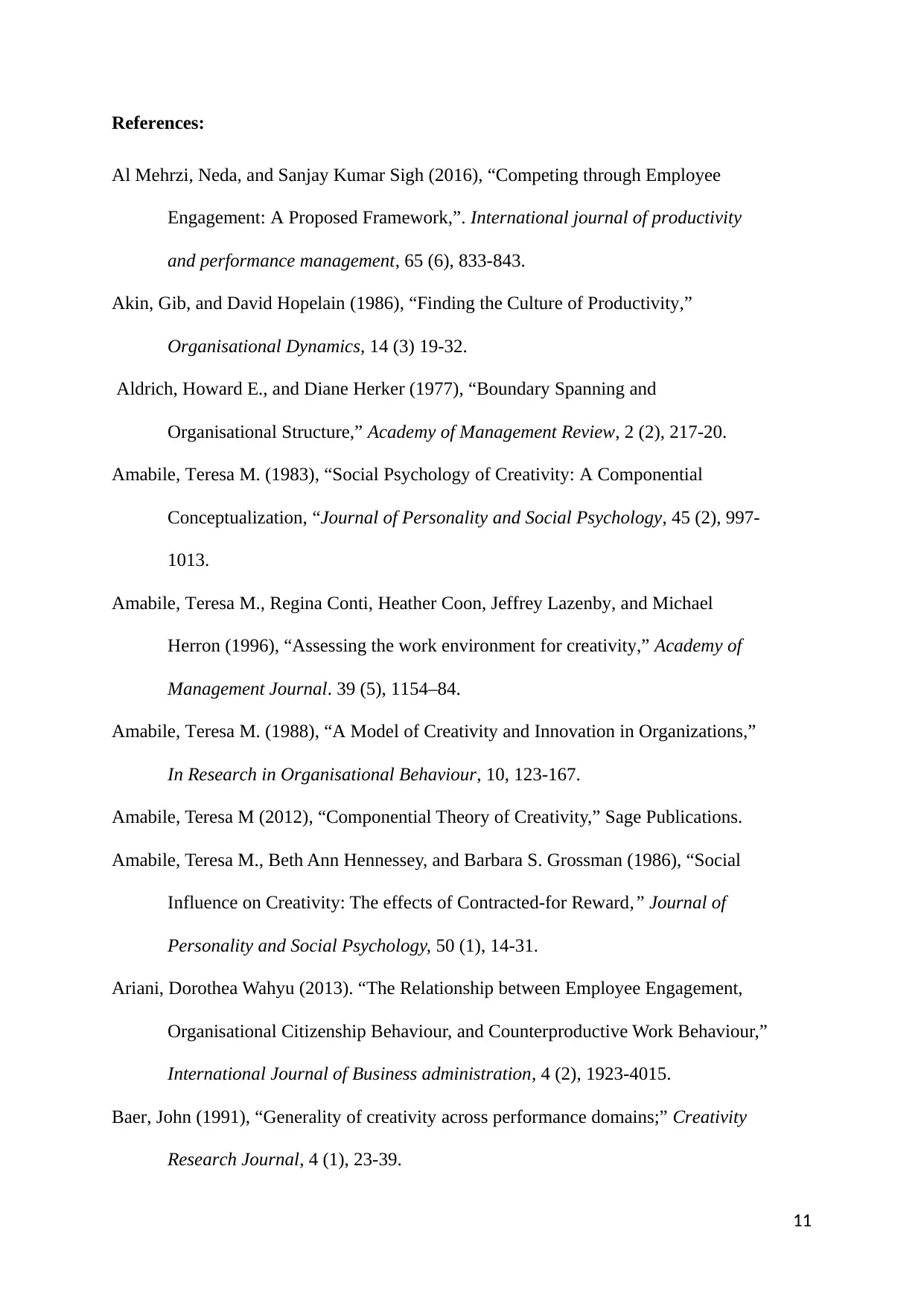
References:
Al Mehrzi, Neda, and Sanjay Kumar Sigh (2016), “Competing through Employee
Engagement: A Proposed Framework,”. International journal of productivity
and performance management, 65 (6), 833-843.
Akin, Gib, and David Hopelain (1986), “Finding the Culture of Productivity,”
Organisational Dynamics, 14 (3) 19-32.
Aldrich, Howard E., and Diane Herker (1977), “Boundary Spanning and
Organisational Structure,” Academy of Management Review, 2 (2), 217-20.
Amabile, Teresa M. (1983), “Social Psychology of Creativity: A Componential
Conceptualization, “Journal of Personality and Social Psychology, 45 (2), 997-
1013.
Amabile, Teresa M., Regina Conti, Heather Coon, Jeffrey Lazenby, and Michael
Herron (1996), “Assessing the work environment for creativity,” Academy of
Management Journal. 39 (5), 1154–84.
Amabile, Teresa M. (1988), “A Model of Creativity and Innovation in Organizations,”
In Research in Organisational Behaviour, 10, 123-167.
Amabile, Teresa M (2012), “Componential Theory of Creativity,” Sage Publications.
Amabile, Teresa M., Beth Ann Hennessey, and Barbara S. Grossman (1986), “Social
Influence on Creativity: The effects of Contracted-for Reward,” Journal of
Personality and Social Psychology, 50 (1), 14-31.
Ariani, Dorothea Wahyu (2013). “The Relationship between Employee Engagement,
Organisational Citizenship Behaviour, and Counterproductive Work Behaviour,”
International Journal of Business administration, 4 (2), 1923-4015.
Baer, John (1991), “Generality of creativity across performance domains;” Creativity
Research Journal, 4 (1), 23-39.
11
Al Mehrzi, Neda, and Sanjay Kumar Sigh (2016), “Competing through Employee
Engagement: A Proposed Framework,”. International journal of productivity
and performance management, 65 (6), 833-843.
Akin, Gib, and David Hopelain (1986), “Finding the Culture of Productivity,”
Organisational Dynamics, 14 (3) 19-32.
Aldrich, Howard E., and Diane Herker (1977), “Boundary Spanning and
Organisational Structure,” Academy of Management Review, 2 (2), 217-20.
Amabile, Teresa M. (1983), “Social Psychology of Creativity: A Componential
Conceptualization, “Journal of Personality and Social Psychology, 45 (2), 997-
1013.
Amabile, Teresa M., Regina Conti, Heather Coon, Jeffrey Lazenby, and Michael
Herron (1996), “Assessing the work environment for creativity,” Academy of
Management Journal. 39 (5), 1154–84.
Amabile, Teresa M. (1988), “A Model of Creativity and Innovation in Organizations,”
In Research in Organisational Behaviour, 10, 123-167.
Amabile, Teresa M (2012), “Componential Theory of Creativity,” Sage Publications.
Amabile, Teresa M., Beth Ann Hennessey, and Barbara S. Grossman (1986), “Social
Influence on Creativity: The effects of Contracted-for Reward,” Journal of
Personality and Social Psychology, 50 (1), 14-31.
Ariani, Dorothea Wahyu (2013). “The Relationship between Employee Engagement,
Organisational Citizenship Behaviour, and Counterproductive Work Behaviour,”
International Journal of Business administration, 4 (2), 1923-4015.
Baer, John (1991), “Generality of creativity across performance domains;” Creativity
Research Journal, 4 (1), 23-39.
11
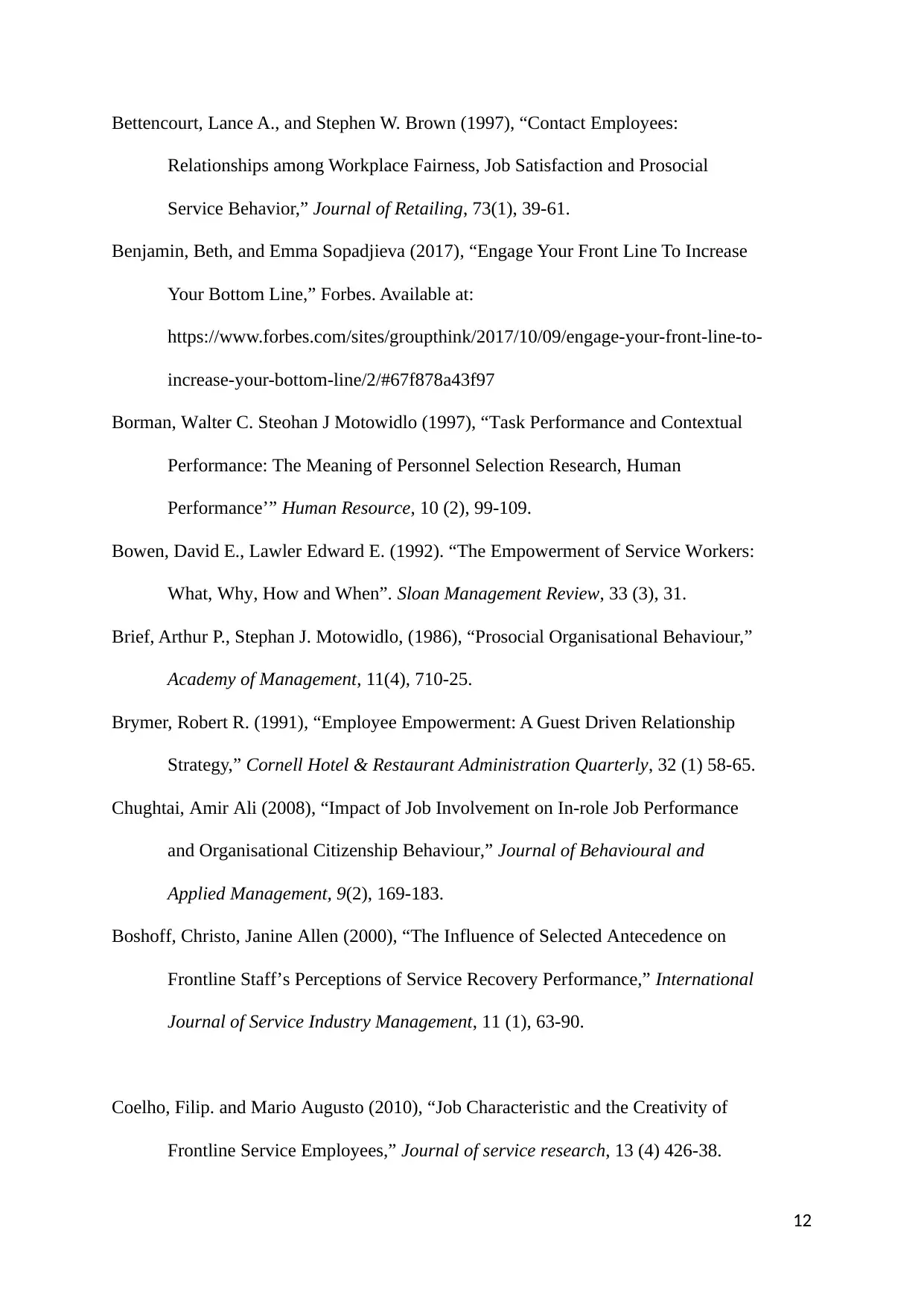
Bettencourt, Lance A., and Stephen W. Brown (1997), “Contact Employees:
Relationships among Workplace Fairness, Job Satisfaction and Prosocial
Service Behavior,” Journal of Retailing, 73(1), 39-61.
Benjamin, Beth, and Emma Sopadjieva (2017), “Engage Your Front Line To Increase
Your Bottom Line,” Forbes. Available at:
https://www.forbes.com/sites/groupthink/2017/10/09/engage-your-front-line-to-
increase-your-bottom-line/2/#67f878a43f97
Borman, Walter C. Steohan J Motowidlo (1997), “Task Performance and Contextual
Performance: The Meaning of Personnel Selection Research, Human
Performance’” Human Resource, 10 (2), 99-109.
Bowen, David E., Lawler Edward E. (1992). “The Empowerment of Service Workers:
What, Why, How and When”. Sloan Management Review, 33 (3), 31.
Brief, Arthur P., Stephan J. Motowidlo, (1986), “Prosocial Organisational Behaviour,”
Academy of Management, 11(4), 710-25.
Brymer, Robert R. (1991), “Employee Empowerment: A Guest Driven Relationship
Strategy,” Cornell Hotel & Restaurant Administration Quarterly, 32 (1) 58-65.
Chughtai, Amir Ali (2008), “Impact of Job Involvement on In-role Job Performance
and Organisational Citizenship Behaviour,” Journal of Behavioural and
Applied Management, 9(2), 169-183.
Boshoff, Christo, Janine Allen (2000), “The Influence of Selected Antecedence on
Frontline Staff’s Perceptions of Service Recovery Performance,” International
Journal of Service Industry Management, 11 (1), 63-90.
Coelho, Filip. and Mario Augusto (2010), “Job Characteristic and the Creativity of
Frontline Service Employees,” Journal of service research, 13 (4) 426-38.
12
Relationships among Workplace Fairness, Job Satisfaction and Prosocial
Service Behavior,” Journal of Retailing, 73(1), 39-61.
Benjamin, Beth, and Emma Sopadjieva (2017), “Engage Your Front Line To Increase
Your Bottom Line,” Forbes. Available at:
https://www.forbes.com/sites/groupthink/2017/10/09/engage-your-front-line-to-
increase-your-bottom-line/2/#67f878a43f97
Borman, Walter C. Steohan J Motowidlo (1997), “Task Performance and Contextual
Performance: The Meaning of Personnel Selection Research, Human
Performance’” Human Resource, 10 (2), 99-109.
Bowen, David E., Lawler Edward E. (1992). “The Empowerment of Service Workers:
What, Why, How and When”. Sloan Management Review, 33 (3), 31.
Brief, Arthur P., Stephan J. Motowidlo, (1986), “Prosocial Organisational Behaviour,”
Academy of Management, 11(4), 710-25.
Brymer, Robert R. (1991), “Employee Empowerment: A Guest Driven Relationship
Strategy,” Cornell Hotel & Restaurant Administration Quarterly, 32 (1) 58-65.
Chughtai, Amir Ali (2008), “Impact of Job Involvement on In-role Job Performance
and Organisational Citizenship Behaviour,” Journal of Behavioural and
Applied Management, 9(2), 169-183.
Boshoff, Christo, Janine Allen (2000), “The Influence of Selected Antecedence on
Frontline Staff’s Perceptions of Service Recovery Performance,” International
Journal of Service Industry Management, 11 (1), 63-90.
Coelho, Filip. and Mario Augusto (2010), “Job Characteristic and the Creativity of
Frontline Service Employees,” Journal of service research, 13 (4) 426-38.
12
⊘ This is a preview!⊘
Do you want full access?
Subscribe today to unlock all pages.

Trusted by 1+ million students worldwide
1 out of 21
Your All-in-One AI-Powered Toolkit for Academic Success.
+13062052269
info@desklib.com
Available 24*7 on WhatsApp / Email
![[object Object]](/_next/static/media/star-bottom.7253800d.svg)
Unlock your academic potential
Copyright © 2020–2025 A2Z Services. All Rights Reserved. Developed and managed by ZUCOL.


